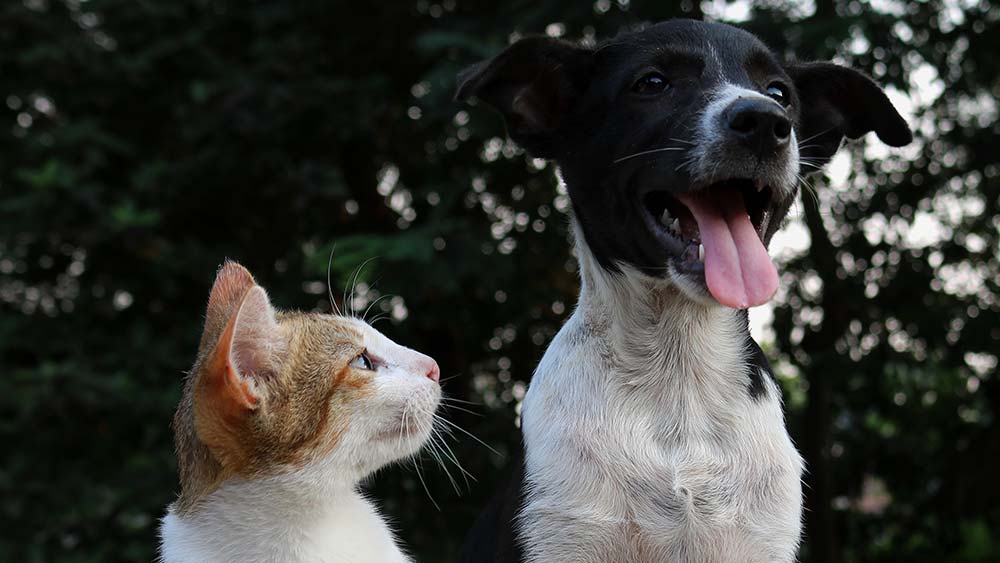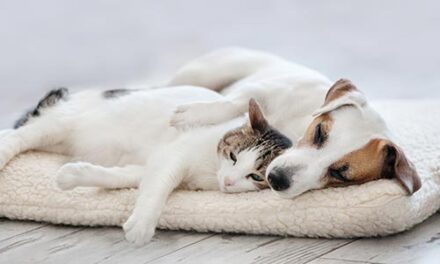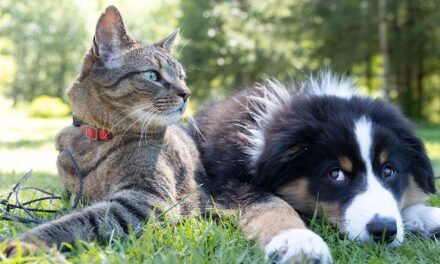Epilepsy is the name given to seizural disorders in dogs and cats for which there is no identifiable cause. Primary epilepsy is the result of functional cerebral disturbances without obvious causes other than a possible hereditary predisposition.
For a diagnosis of epilepsy to be made, other causes of seizures (including poisoning, infection, tumors, and cranial trauma) must be ruled out through diagnostic testing. While true epilepsy can occur in pets of any age, most commonly dogs and cats with epilepsy begin demonstrating seizures between six months and five years of age.
Seizures occur in epileptic pets as hyperexcitable neurons within the brain that show activity. As the development of progressive and refractory seizures correlates with the number of seizures, early diagnosis and treatment are important in preventing a worsening of future seizures. Generally, conventional anti-epileptic medicine is not prescribed unless the pet has at least one seizure per month, as the goal of treatment is to reduce, rather than to eliminate, seizure frequency, severity, and length.
PRINCIPAL NATURAL TREATMENTS
Natural diet
A number of pets with epilepsy have been reported (through anecdotal reports) to show improvement upon dietary manipulation. Suggested dietary changes (which may decrease a food hypersensitivity that causes the pet to seizure) include: diets free of red meat, homemade diets free of common dietary allergens (beef, chicken, corn), diets free of preservatives, and diets using minimally processed foods. Some pets may also be sensitive to the flavoring in monthly or daily heartworm preventative medications; therefore, using a non-flavored product may also be helpful when dietary manipulation alone is not successful. Since seizures are a medical problem, owners should not try dietary manipulation without a proper diagnosis and veterinary supervision.
Choline/Lecithin
Lecithin contains a substance called phosphatidylcholine (PC) that is presumed to be responsible for its medicinal effects. Phosphatidylcholine is a major part of the membranes surrounding our cells. However, when phosphatidylcholine is consumed, it is broken down into choline rather than being carried directly to cell membranes. Choline acts like folic acid, TMG (trimethylglycine), and SAMe (s-adenosylmethionine) to promote methylation. It is also used to make acetylcholine, a nerve chemical essential for proper brain function.
Choline and phosphatidylcholine are effective for treating human neurological disorders with presumed choline deficiencies including tardive dyskinesia, Huntington’s chorea, and Friedreich’s ataxia. For use as a supplement or a food additive, lecithin is often manufactured from soy.
One Choline-containing product that has been used successfully in pets is Cholodin. Cholodin contains choline, phosphatidylcholine, DL-methionine, and vitamins and minerals. Choline provides methyl groups used by the body in a number of biological reactions and acts as a precursor of acetylcholine. Phosphatidylcholine (lecithin) is part of the plasma membrane of mammalian cells and also provides additional choline for acetylcholine synthesis. Methionine and inositol also are involved in neurotransmitter metabolism.
Due to its ability to interact with cells of the nervous system, cholodin is also recommended for pets with epilepsy. Studies have shown decreased seizure frequency in pets supplemented with products containing increased levels of choline and phosphatidylcholine. Cholodin, given at one to two pills daily for a small dog or cat, and two to four pills daily for a large dog, and other choline-containing products can be tried to determine effectiveness under your veterinarian’s supervision. Do not stop anti-epileptic drugs without your veterinarian’s permission.
Lecithin is believed to be generally safe. However, some people taking high dosages (several grams daily) experience minor but annoying side effects, such as abdominal discomfort, diarrhea, and nausea. Maximum safe dosages for young children, pregnant or nursing women, or those with severe liver or kidney disease have not been determined; the same precautions are probably warranted in pets.
Orthomolecular therapy
Orthomolecular medicine (often called “megavitamin therapy”) seeks to use increased levels of vitamins and minerals (mainly antioxidants) to help treat a variety of medical disorders. While daily amounts of vitamins and minerals have been recommended as an attempt to prevent nutritional deficiencies, orthomolecular medicine uses higher doses as part of the therapy for disease.
The pet food industry relies on recommendations by the national research council (NRC) to prevent diseases caused by nutrient deficiencies in the “average” pet, yet the NRC has not attempted to determine the optimum amount of nutrients or their effects in treating medical disorders. While a minimum amount of nutrients may be satisfactory in preventing diseases caused by nutrient deficiencies, it is important to realize there is no “average” pet, and every pet has unique nutritional needs.
It is unlikely that our current recommendations are adequate to maintain health in every pet. Each pet has unique requirements for nutrients. Additionally, these needs will vary depending upon the pet’s health. For example, in times of stress or disease additional nutrients above and beyond those needed for health will be required. Orthomolecular medicine evaluates the needs of the pet and uses increased nutrients to fight disease.
Note: owners should not diagnose and treat their pets without veterinary supervision. Many medical disorders present similar symptoms. Also, megavitamin therapy can be toxic if not used properly.
As mentioned, correcting the diet is important as there is anecdotal evidence that food hypersensitivity may be the cause of seizures in some pets. A small number of cases treated concurrently with anticonvulsant medicines plus antioxidants have shown promise and allowed a reduction or elimination of seizures. While more cases must be treated before any conclusions can be reached, using antioxidant vitamins and minerals may be helpful in selected patients with epilepsy.
Treatment uses vitamin a (10,000 IU for small dogs and cats, up to 30,000 IU for large dogs), crystalline ascorbic acid (750 mg for small dogs and cats, up to 3,000 mg for large dogs), and vitamin E (800 IU for small dogs and cats, up to 2,400 IU for large dogs). The antioxidant mineral selenium (20 mcg for small dogs and cats, up to 60 mcg for large dogs) is also added to the regimen. Once asymptomatic, a maintenance protocol using gradually lower dosages of vitamins A and E and the mineral selenium are prescribed to reduce the chance for toxicity. Promising results have been seen in many pets treated with this regimen.
Other Natural Treatments
Bach flower essences, DMG, taurine, thyroid supplement/glandulars, herbs, Ginkgo biloba, gotu kola, kava kava, skullcap, valerian, B vitamins and magnesium.
Note:some doctors have reported success with tyrosine, given in combination with taurine at five to ten mg per pound (of each supplement) of body weight one to two times daily, which may also reduce seizures by increasing the seizure threshold.
These therapies can be used in conjunction with conventional therapies as they are unlikely to be effective by themselves in most patients with severe disease. The natural treatments are widely used with variable success but have not been thoroughly investigated and proven at this time.
As with any condition, the most healthful natural diet will improve the pet’s overall health.
CONVENTIONAL THERAPY
Conventional therapy involves various anticonvulsant medications, including Phenobarbital, potassium bromide or valium. Phenobarbital is commonly used to control seizures in dogs and cats with epilepsy. Side effects include increased thirst, urination, and appetite; occasionally, excessive sedation and a wobbly gait are seen, especially as the dosage increases. Increased liver enzymes, which may or may not be associated with liver damage, can be seen, as can anemia. Dogs and cats taking Phenobarbital should be reevaluated periodically and have regular blood profiles to monitor side effects and therapeutic blood levels (generally every three to six month).
Potassium bromide is not approved for use in dogs and cats but has become a popular medication for the control of seizures in dogs. It appears to be a safer medication than Phenobarbital (fewer side effects), although Phenobarbital rarely produces any significant side effects in dogs. Potassium bromide can be used in dogs as the sole therapeutic agent, in combination with phenobarbital (if needed), or in place of Phenobarbital for those dogs whose seizures are not adequately controlled with Phenobarbital or who suffer from secondary liver disease as a result of Phenobarbital therapy. Many doctors are now using potassium bromide as the initial (and often only) medical therapy for dogs with epilepsy.
Side effects of potassium bromide may include tremors, stupor, wobbly gait, lack of appetite, vomiting and constipation. Potassium bromide may rarely cause pancreatitis when it is used in combination with Phenobarbital or primidone (another anticonvulsant that is rarely used in dogs). Dogs placed on low-salt diets may have increased bromide toxicity as a result of decreased chloride ion levels. Extra salt in the diet, as well as use of diuretics, may decrease the blood levels of bromide and increase the frequency of seizures. Dogs taking potassium bromide should be reevaluated periodically and have regular blood profiles to monitor side effects and therapeutic blood levels (generally every three to six months).
Valium is most commonly used as an injection for pets in status epilepticus, which is a state of active, ongoing seizures. Valium is not usually used as a sole medication for treating dogs with epilepsy, although it may be used as the sole agent in treating epileptic cats. Oral administration of diazepam has been rarely associated with severe liver disease in cats. Cats taking diazepam on a regular basis should be frequently tested for liver disease.











